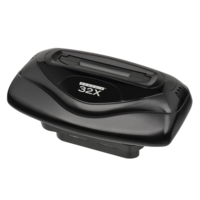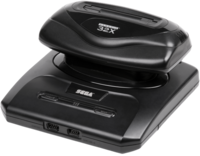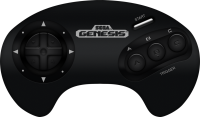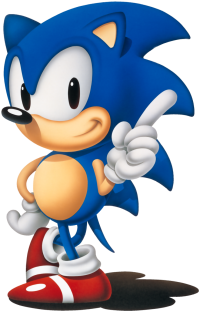Sega 32x (32x)

Sega 32X is an add-on for the Sega Mega Drive game console. The 32X, codenamed "Project Mars", was designed to expand the capabilities of the Mega Drive and served as a transitional prefix to the 32-bit era until the release of the Sega Saturn. Regardless of the Mega Drive, the 32X uses its own game cartridges and has its own library of games. It was distributed under the names Super 32X in Japan, Genesis 32X in North America, Mega Drive 32X in countries using the PAL system, and Mega 32X in Brazil.
Introduced by Sega at the Consumer Electronics Show in June 1994, the 32X was introduced as an inexpensive option for consumers looking to play 32-bit games. It was developed in response to the Atari Jaguar and due to concerns that the Saturn would not be on the market by the end of 1994. Although it was conceived as a new, standalone console by Sega Japan, at the suggestion of Sega of America CEO Joe Miller and his team, it became an addition to the Mega Drive and became more powerful. The final design contained two 32-bit CPUs and a 3D GPU.
32X was unable to attract third-party video game developers and consumers due to the announcement of the simultaneous release of the Saturn in Japan. Sega's efforts to rush the 32X to market shortened the time available for game development, resulting in a weak library of 40 games that did not fully utilize the device's hardware. Sega produced 800,000 32Xs and sold an estimated 665,000 units by the end of 1994. Other copies were sold at deep discounts until Sega discontinued the 32X in 1996, turning its attention to the Saturn.
32X is considered a commercial failure. Initial reception was positive, with reviewers emphasizing the low price and enhanced features over the Mega Drive. However, later reviews were mostly negative due to the small game library, poor timing of the market launch, and fragmentation of the Mega Drive console market.

In 1988, Sega released the Genesis console, which in Europe and Japan was called the Mega Drive. In 1991, Sega released an add-on to the Mega Drive, the Sega Mega-CD device, which fell short of commercial expectations. Sega began development on a second expansion that would bridge the gap between the Mega Drive and the upcoming Sega Saturn, and be a less expensive entry into the 32-bit era. Sega was determined to release the new expansion before the end of 1994. According to former Sega of America CEO Thomas Kalinske, “The original argument was that we could live another year on the Genesis before we had to introduce the Saturn. Japan did not agree with me on this issue, so 32X appeared as a temporary measure.
During the winter Consumer Electronics Show in January 1994, Sega of America head of research and development Joe Miller received a phone call from Sega president Hayao Nakayama in his Las Vegas hotel room, in which Nakayama stressed the importance of a quick response to the company's Jaguar console. atari. Kev Bayliss, Sega's Head of Hardware Hideki Sato, and Sega of America's Vice President of Technology Marty Franz participated in this conversation. One potential idea came from the Japanese team's concept. This idea, later known as "Project Jupiter", was a completely new independent prefix. Former Sega of America producer Michael Latham called it "Genesis 2".
Project Jupiter was originally planned as a new version of the Mega Drive, with an updated color palette and a lower cost than the upcoming Saturn, as well as some limited 3D capabilities due to the integration of ideas gained during the development of the Sega Virtua Processor chip. Miller insisted on a different strategy - according to Latham, Miller dismissed Project Jupiter as "just a terrible idea. If all you're going to do is improve the system, then you should make it an extension. If it's a new system with brand new software, great. But if the only thing she does is double the colors.... Miller said that his idea was to create a new system in the form of an add-on. He claimed that the decision was made to use the existing Mega Drive as a way of not scaring off Sega consumers who would otherwise have to completely abandon their previously purchased Mega Drive consoles in order to play 32-bit games. As a result of these discussions, development of Project Jupiter ceased and a new add-on codenamed "Project Mars" was started.
Miller suggested that the development of the add-on be given to an American team, and as a result, the 32X was developed as a peripheral for the existing Mega Drive, expanding its capabilities with two new 32-bit SuperH-2 processors, the same as those used in the Saturn, but with a lower clock speed. The SH-2 processor was developed in 1993 as a joint venture between Sega and the Japanese company Hitachi. The original design of the 32X add-on, according to Bayliss, was created on a cocktail napkin, but Miller denies this. In another story, Bayliss claims that Franz began designing the 32X on a hotel sketchpad, drawing two SH-2 processors with separate frame buffers.

Although the new device was more powerful than originally proposed, it was not compatible with Saturn games. This was justified by Sega's announcement that both platforms would be sold at the same time and that the 32X would be aimed at players who could not afford the more expensive Saturn. Bayliss praised the system's potential, calling it "a programmer's dream today" with its dual processors and 3D graphics capabilities. Sega of America led the development of the 32X with some help from the Sato team in Japan. Development of the 32X was hampered by a shortage of processors, since the 32X and Saturn used the same 32-bit chips, as well as a language barrier between teams in Japan and the United States.
Prior to the launch of the 32X, the Saturn's release date was set for November 1994 in Japan, coinciding with the 32X's release date in North America. Sega of America was tasked with marketing the 32X with a simultaneous launch of the Saturn in Japan. As a result, they called the 32X a "crossover" between the Mega Drive and the Saturn; Bayless said it "just made us look greedy and stupid in front of consumers."
The presentation of the 32X took place at the summer Consumer Electronics Show in June 1994 in Chicago. The 32X was positioned as a low cost alternative to the Saturn, priced at US$159. However, Sega did not answer the question of whether the Mega Drive set-top box, equipped with a Sega CD and 32X, would be able to run the Saturn software. The 3DO Company founder Trip Hawkins pointed out that this was not the case, stating "Everyone knows the 32X is a patch. This is not a “next generation system”. She's pretty expensive. It's not particularly productive. It is difficult for her to program and is not compatible with the Saturn." In response to these comments, Sega executive Richard Brodwick-Lindner noted that the 32X would run Mega Drive games and share the same system architecture as the Saturn.
In August of the same year, GamePro magazine singled out 32-bit processors and a significantly lower price as an advantage of the upcoming expansion, noting that "no doubt gamers who tend to buy things right away will spend big bucks to get their hands on Saturn or PlayStation systems and games. to them from Japan. For the rest, however, the 32X may very well be the 1994 system of choice.” As part of promoting the new system, Sega promised that 12 games would be available at launch, and that 50 more third-party games would be released in 1995.
32X was released on November 21, 1994 in North America, in time for that year's holiday season. As advertised, it retailed for $159.99 and got off to a pretty good start in the market. Demand from retailers was very high, and Sega was unable to keep up with orders for the new system. Over a million orders were placed for the 32X, but by January 1995, Sega was only able to ship 600,000 units. In the United States, nearly 500,000 copies had been sold by Christmas 1994, exceeding Sega's original sales forecast. The 32X hit the market at about the same price as the Mega Drive and was less than half the Saturn's starting price. Despite Sega's initial promises, only six games were available in the North American market, including Doom, Star Wars Arcade, Virtua Racing Deluxe, and Cosmic Carnage. Although Virtua Racing was considered a quality game, Cosmic Carnage "looked and played so badly that reviewers joked about it." The games were sold for a retail price of US$69.95. 32X was released in Japan on December 3, 1994. The release of the system in PAL countries took place in January 1995 at a price of 169.99 pounds and was also in high demand.
Although the add-on was positioned as an inexpensive way to get into 32-bit games, Sega found it difficult to convince third-party developers to create games for the new system. Leading developers were already aware of the upcoming Sega Saturn, Nintendo 64, and PlayStation and didn't believe the 32X could compete with those systems. The fast 32X development time also made game development difficult, according to Franz. Not wanting to waste time on an add-on that was considered a "technological dead end", many developers decided not to make games for this system. In-house developed games have had issues due to lack of time to release 32X. According to Bayliss, “the games that were in the development queue were actually being pushed into the box as quickly as possible, which meant cutting corners en masse in every possible way. Even from the start, the design of these games was deliberately conservative due to time constraints. By the time of delivery, they became even more conservative; the games didn't do anything to show what the hardware was capable of." Kalinske stated that in the development of games Sega of America did not receive sufficient support from the Japanese branch. The development kits came out very late, leaving little time for game development before the 32X release.
Journalists have also expressed concern about Sega's tactic of selling two similar consoles at different prices and trying to support both, comparing Sega's approach to that of General Motors and noting that the companies are segmenting their market in this way. To convince the press that the 32X was a noteworthy console, Sega invited journalists from all over the country to San Francisco for a party at one of the local nightclubs. The event featured Kalinske giving a speech, live music with a local rapper praising 32X, and a showcase of 32X games. However, the event proved unsuccessful as the journalists attempted to leave the party due to the loud music and unimpressive games at the expo, only to find that the buses taking them to the nightclub had just left and would not return until the party was scheduled to end.

Despite the successful launch of the system, the demand for it soon disappeared. During the first three months of 1995, several third-party publishers, including Capcom and Konami, canceled their projects for the 32X to focus on releasing games for the Saturn and PlayStation. 32X failed to catch on with the public and is considered a commercial failure. By 1995, the Mega Drive was still not making headway in Japan, and the Saturn was beating the PlayStation, so Sega CEO Hayao Nakayama decided to force Sega of America to focus on the Saturn and stop supporting Mega Drive products with a surprise early Saturn launch in early summer 1995. . Prior to this, Sega supported five different consoles - Saturn, Mega Drive, Game Gear, Pico and Master System, as well as add-ons in the form of Sega CD and Sega 32X. Estimated, by the end of 1994, 32X sales were 665,000 units. Despite Sega's assurances that many games would be developed for the system, Sega finally admitted in early 1996 that it had promised too much and decided to discontinue the 32X in order to focus on the Saturn. In September 1995, the retail price for the 32X was reduced to $99, and later the remaining stock was sold out of stores for $19.95, with a total of 800,000 units sold.
GAMES
The Sega 32X library consists of 40 games, including six that require both the 32X and the Sega CD. These included ports of the arcade games After Burner, Space Harrier and Star Wars Arcade, the side-scroller Kolibri, and a 32X-exclusive Sonic the Hedgehog spin-off Knuckles' Chaotix. Several games released for the 32X are enhanced ports of Mega Drive games, including NFL Quarterback Club and World Series Baseball '95. IGN's retrospective review of the console named Star Wars Arcade the best game for the 32X for its co-op mode, soundtrack, and faithful reproduction of the Star Wars experience. In a separate review, IGN's Levi Buchanan praised the 32X game Shadow Squadron and called it superior to Star Wars Arcade. However, Retro Gamer reviewer Damien McFerran called Virtua Fighter "the jewel in the 32X crown" and GamesRadar+ named Knuckles' Chaotix the best game on the system. Next Generation called Virtua Fighter "a colorful wreath on the 32X's coffin", reflecting the consensus of contemporary critics that the game was both arguably the best project for the 32X and a clear harbinger of the imminent demise of the platform, as it was inferior to the already released Saturn version of Virtua Fighter Remix, as well as the upcoming Saturn project Virtua Fighter 2. In response to fan inquiries, Sega stated that the 32X architecture was not powerful enough to port Virtua Fighter 2.

Although the console used 32-bit technology and was capable of better graphics and sound than the Mega Drive, most 32X games did not take advantage of its hardware. The 32X game Doom received close to perfect reviews in gaming magazines upon release, but was later criticized for being inferior compared to the PC and Atari Jaguar versions: the 32X version was criticized for missing some levels, poor graphics quality, and sound, jerks when moving, and for the fact that the action took place in a small window on the screen. Although the system had enhanced audio capabilities, the 32X games did not use them, which Franz believes is due to the developers' reluctance to invest in game development to work with the new audio capabilities. One source of these problems was the rush to release games for the 32X. Former Sega of America executive producer Michael Latham spoke about Cosmic Carnage, the launch game for the 32X: “We were rushed. We had to release games for the 32X on a very tight schedule. When Cosmic Carnage was finished, we didn't even want to release it. It took a lot of persuasion to release this game." Doom followed a similar pattern, with id Software's John Carmack rushing to get the game ready for release at 32X and was forced to cut a third of the game's levels to meet the deadline and release the port on time. Due to time constraints, the game's graphic design was intentionally conservative and did not show what the 32X's hardware was capable of. In an interview in late 1995, Sega's vice president of marketing Mike Ribero, insisting that Sega was not abandoning the 32X, acknowledged that the system's software support was insufficient: “I'm not going to lie to you, we miscalculated with 32X. We overpromised and didn't deliver."
Specifications
The 32X uses two 32-bit Hitachi SuperH-2 chips as the CPUs of the 32X. The Sega 32X can only be used with the Sega Mega Drive. It connects via a standard game cartridge connector, but requires a separate power supply and a cable connecting it to the Mega Drive. In addition to working with its own game cartridges, the 32X is backwards compatible with Mega Drive games and can also be used in conjunction with Sega CD to run games using both expansions. The 32X also came with a spacer to fit properly on the second model of the Mega Drive. A splitter was also optionally offered for use with the Sega Multi-Mega system, but it ultimately never came out due to the risk of electrical shock when using it.
The dimensions of the 32X mounted on the Mega Drive are 115mm x 210mm x 100mm. The 32X uses two Hitachi SH-2 32-bit RISC processors clocked at 23 MHz, which Sega claims allows the system to run 40 times faster than a standalone Mega Drive box without a device. Its GPU is capable of 32,768 colors and renders 50,000 polygons per second, which provides a noticeable improvement in graphics compared to the Mega Drive. The 32X also has 256 kilobytes of random access memory (RAM) as well as 256 kilobytes of video memory. The sound is output through a Pulse Width Modulated sound source. The video signal is fed to the TV via the supplied A/V cable, which provides composite video and stereo sound, or via an RF modulator.
SEGA 32X games TOP 10
Top Sega games 32X according to the Internet:
 1 - Knuckles` Chaotix
1 - Knuckles` Chaotix
2 - Virtua Racing Deluxe
3 - Mortal Kombat II
4 - Virtua Fighter
5 - Blackthorne
6 - After Burner Complete
7 - Doom
8 - Shadow Squadron
9 - Pitfall
10 - Kolibri